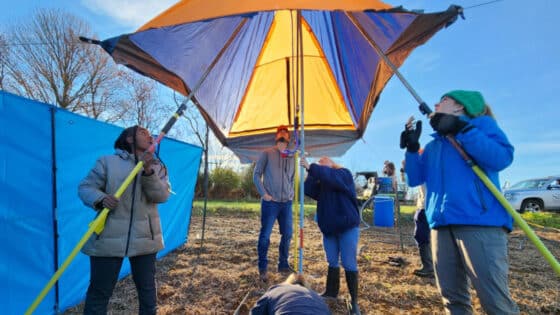Ensign, S.H., M.W. Doyle, and M.F. Piehler. 2012. Freshwater Biology 57(10):2141–2155.
doi: 10.1111/j.1365-2427.2012.02856.x
Summary
- Coastal rivers can have long tidally influenced reaches that are affected by tides but do not contain saline water. These tidal freshwater reaches have steep geomorphic gradients where the river transitions from narrow, heavily shaded streams to wide, unshaded channels. The influence of these gradients on river ecosystem production is poorly understood.
- We characterised gradients in irradiance, geomorphology, water clarity and chlorophyll a along 9‐ to 16‐km tidal freshwater reaches of the Newport and White Oak Rivers in North Carolina, USA, and examined the effect of nutrient enrichment on phytoplankton growth in the Newport River. Underwater irradiance was modelled at 2–4 week intervals along both rivers using measurements of the above‐canopy irradiance, canopy cover, water column light attenuation (Kd) and water depth. Suspended material (TSS), dissolved organic carbon (DOC) and chlorophyll a were sampled at 2‐week interval at five sites on the Newport River and on four dates at four sites on the White Oak River over the course of one year.
- Phytoplankton nutrient limitation was assessed at three locations along the tidal gradient. River water was collected during March, April, June and October, and incubated in 10‐L plastic outdoor containers under ambient water temperature and sunlight. Additions of inorganic nitrogen and phosphorus served as treatments; growth rate during the 4 days of incubation was calculated from the change in chlorophyll a concentration over time.
- Canopy cover decreased from more than 90% to <10% over the length of both tidal freshwater rivers. Water column irradiance and phytoplankton biomass increased as tree canopy cover decreased and channel width increased. Channel width exceeded predictions for non‐tidal rivers by threefold because of tidal influence. TSS and DOC decreased significantly along the length of the Newport River, but no significant gradients were observed in the White Oak River. Kd did not vary along the tidal gradient of either river.
- Mesocosm experiments indicated that inorganic nitrogen and phosphorus enhanced the growth of phytoplankton advected from the non‐tidal river into the tidal freshwater river during spring and summer. Phytoplankton in the tidal freshwater reach were generally not nutrient limited.
- Tidal hydrology (in the absence of saltwater) directly affected the morphology of the channel and indirectly affected biological growth and production. The significant increase in river width, irradiance and phytoplankton biomass distinguished these tidal freshwater ecosystems from their upstream (non‐tidal fluvial) counterparts, while the strong influence of riparian shading distinguished them from the saline estuaries downstream. Future development of ecosystem and biogeochemical models for tidal freshwater rivers will benefit from the linkages between geomorphology and biological processes identified here.


